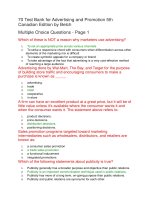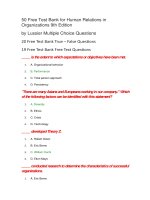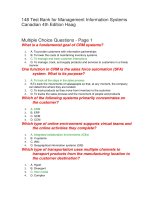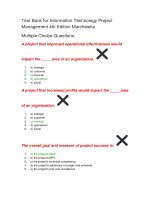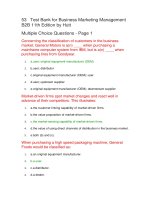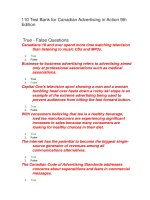Test bank for core concepts in pharmacology 4th edition by holland
Bạn đang xem bản rút gọn của tài liệu. Xem và tải ngay bản đầy đủ của tài liệu tại đây (325.33 KB, 36 trang )
Link full download: />
Test Bank for Core Concepts in Pharmacology 4th Edition by Holland
Chapter 16
Question 1
Type: MCSA
Which client statement demonstrates understanding of the link between cardiovascular
disease and high cholesterol?
1.
2.
3.
4.
“There is no link between cardiovascular disease and cholesterol levels.”
“My diet does not need to be changed to help control my cardiovascular risk.”
“The only people at risk for high cholesterol are those with a family history.”
“The greater the amount of cholesterol circulating in the blood, the greater the risk
of cardiovascular disease.”
Correct Answer: 4
Rationale 1: “There is no link between cardiovascular disease and cholesterol levels” is
incorrect because the higher the level of cholesterol in the body, the higher the
cardiovascular risk.
Rationale 2: “My diet does not need to be changed to help control my cardiovascular
risk” is incorrect because a diet high in fat can increase the cholesterol level and
cardiovascular risk.
Rationale 3: “The only people at risk for high cholesterol are those with a family
history” is incorrect because many people have high cholesterol without a family history.
Rationale 4: The greater the amount of cholesterol circulating in the blood, the greater
the risk of cardiovascular disease.
Global Rationale: The greater the amount of cholesterol circulating in the blood, the
greater the risk of cardiovascular disease. “There is no link between cardiovascular
disease and cholesterol levels” is incorrect because the higher the level of cholesterol in
the body the higher the cardiovascular risk. “My diet does not need to be changed to help
control my cardiovascular risk” is incorrect because a diet high in fat can increase the
cholesterol level and cardiovascular risk. “The only people at risk for high cholesterol are
those with a family history” is incorrect because many people have high cholesterol
without a family history.
Cognitive Level: Applying
Client Need: Physiological Integrity
Client Need Sub:
Nursing/Integrated Concepts: Nursing Process: Implementation
Learning Outcome: 16-1 Summarize the links among high blood cholesterol, lowdensity lipoprotein (LDL) levels, and cardiovascular disease.
Question 2
Type: MCSA
The nurse is educating a group of clients on how high cholesterol leads to heart disease.
Which explanation regarding high cholesterol is most appropriate?
1.
2.
3.
4.
It interferes with the conduction system of the heart.
It binds to vessel walls, decreasing the amount of blood getting to the heart.
It thickens the blood, causing clots.
It damages the heart muscle.
Correct Answer: 2
Rationale 1: “It interferes with the conduction system of the heart” is incorrect because
cholesterol does not damage the heart muscle nor does it interfere with the conduction
system of the heart.
Rationale 2: Circulating cholesterol binds to vessel walls, increasing plaque buildup
through the years. The greater the amount of cholesterol circulating in the blood, the
greater is the risk of cardiovascular disease.
Rationale 3: “It thickens the blood, causing clots” is incorrect because lipoproteins are
transported freely throughout the blood, but they do not make the blood clot quicker.
Rationale 4: “It damages the heart muscle” is incorrect because cholesterol does not
damage the heart muscle nor does it interfere with the conduction system of the heart.
Global Rationale: Circulating cholesterol binds to vessel walls, increasing plaque
buildup through the years. The greater the amount of cholesterol circulating in the blood,
the greater is the risk of cardiovascular disease. It interferes with the conduction system
of the heart is incorrect because cholesterol does not damage the heart muscle nor does it
interfere with the conduction system of the heart. It thickens the blood, causing clots is
incorrect because lipoproteins are transported freely throughout the blood, but they do not
make the blood clot quicker. It damages the heart muscle is incorrect because cholesterol
does not damage the heart muscle nor does it interfere with the conduction system of the
heart.
Cognitive Level: Applying
Client Need: Health Promotion and Maintenance
Client Need Sub:
Nursing/Integrated Concepts: Nursing Process: Implementation
Learning Outcome: 16-1 Summarize the links among high blood cholesterol, lowdensity lipoprotein (LDL) levels, and cardiovascular disease.
Question 3
Type: MCMA
The nurse instructs the client that which foods contain high amounts of Omega-3 fatty
acids?
(Select all that apply.)
Note: Credit will be given only if all correct choices and no incorrect choices are
selected.
1.
2.
3.
4.
5.
Green beans
Bananas
Tofu
Salmon
Red meat
Correct Answer: 3, 4
Rationale 1: Green beans is incorrect because they do not contain high amounts of
Omega-3 fatty acids.
Rationale 2: Bananas is incorrect because they do not contain high amounts of Omega-3
fatty acids.
Rationale 3: Tofu contains high amounts of Omega-3 fatty acids.
Rationale 4: Salmon contains high amounts of Omega-3 fatty acids.
Rationale 5: Red meat is incorrect because it does not contain high amounts of Omega-3
fatty acids.
Global Rationale: Tofu and salmon contain high amounts of Omega-3 fatty acids. Green
beans, bananas, and red meat are incorrect because they do not contain high amounts of
Omega-3 fatty acids.
Cognitive Level: Applying
Client Need: Health Promotion and Maintenance
Client Need Sub:
Nursing/Integrated Concepts: Nursing Process: Implementation
Learning Outcome: 16-1 Summarize the links among high blood cholesterol, lowdensity lipoprotein (LDL) levels, and cardiovascular disease.
Question 4
Type: MCSA
The client asks which components of the lipid profile should be low. What is the most
appropriate response by the nurse?
1.
2.
3.
4.
VLDL should be high.
LDL should be low.
Total cholesterol levels do not give sufficient information.
HDL should be low.
Correct Answer: 2
Rationale 1: “VLDL should be high” is incorrect because VLDL should be within
normal limits, and high levels are not well understood but are associated with increased
risk of pancreatitis.
Rationale 2: Low-density lipoprotein (LDL or the “bad” cholesterol should be low).
Rationale 3: “Total cholesterol levels do not give sufficient information” is incorrect
because total cholesterol levels should be within normal limits, and the components of the
total determine what treatment may be selected.
Rationale 4: “HDL should be low” is incorrect because high-density lipoprotein (HDL or
the “good” cholesterol) levels should be high.
Global Rationale: Low-density lipoprotein (LDL or the “bad” cholesterol should be
low). VLDL should be high is incorrect because VLDL should be within normal limits,
and high levels are not well understood but are associated with increased risk of
pancreatitis. Total cholesterol levels do not give sufficient information is incorrect
because total cholesterol levels should be within normal limits, and the components of the
total determine what treatment may be selected. HDL should be low is incorrect because
high-density lipoprotein (HDL or the “good” cholesterol) levels should be high.
Cognitive Level: Applying
Client Need: Physiological Integrity
Client Need Sub:
Nursing/Integrated Concepts: Nursing Process: Implementation
Learning Outcome: 16-4 Compare and contrast the different types of lipoproteins.
Question 5
Type: MCSA
What is the major storage form of fat in the body and the only type of lipid that serves as
an important energy source?
1.
2.
3.
4.
HDL
Cholesterol
LDL
Triglycerides
Correct Answer: 4
Rationale 1: HDL is incorrect because triglycerides are the major storage form of fat in
the body and the only type of lipid that serves as an important energy source.
Rationale 2: Cholesterol is incorrect because triglycerides are the major storage form of
fat in the body and the only type of lipid that serves as an important energy source.
Rationale 3: LDL is incorrect because triglycerides are the major storage form of fat in
the body and the only type of lipid that serves as an important energy source.
Rationale 4: Triglycerides are the major storage form of fat in the body and the only type
of lipid that serves as an important energy source.
Global Rationale: Triglycerides are the major storage form of fat in the body and the
only type of lipid that serves as an important energy source. HDL is incorrect because
triglycerides are the major storage form of fat in the body and the only type of lipid that
serves as an important energy source. Cholesterol is incorrect because triglycerides are
the major storage form of fat in the body and the only type of lipid that serves as an
important energy source. LDL is incorrect because triglycerides are the major storage
form of fat in the body and the only type of lipid that serves as an important energy
source.
Cognitive Level: Applying
Client Need: Health Promotion and Maintenance
Client Need Sub:
Nursing/Integrated Concepts: Nursing Process: Implementation
Learning Outcome: 16-4 Compare and contrast the different types of lipoproteins.
Question 6
Type: MCSA
The client asks how the body gets rid of cholesterol. Which response by the nurse is the
most appropriate?
1.
2.
3.
4.
Cholesterol is secreted as HDL.
Cholesterol is secreted through the kidneys.
Cholesterol is secreted in bile.
Cholesterol is secreted in feces.
Correct Answer: 3
Rationale 1: As HDL is incorrect because high-density lipoprotein (HDL) picks up
cholesterol in the blood and other tissues and returns it to the liver where it is used to
make bile. Bile is essential for the digestion of lipids. The cholesterol component of bile
is then excreted in the feces, though some may be reabsorbed back into the circulation.
Excretion via bile is the only route the body uses to remove cholesterol.
Rationale 2: Through the kidneys is incorrect because the liver is the organ of excretion.
Rationale 3: High-density lipoprotein (HDL) picks up cholesterol in the blood and other
tissues and returns it to the liver where it is used to make bile. Bile is essential for the
digestion of lipids. The cholesterol component of bile is then excreted in the feces,
though some may be reabsorbed back into the circulation. Excretion via bile is the only
route the body uses to remove cholesterol.
Rationale 4: In feces is incorrect because high-density lipoprotein (HDL) picks up
cholesterol in the blood and other tissues and returns it to the liver where it is used to
make bile. Bile is essential for the digestion of lipids. The cholesterol component of bile
is then excreted in the feces, though some may be reabsorbed back into the circulation.
Excretion via bile is the only route the body uses to remove cholesterol.
Global Rationale: High-density lipoprotein (HDL) picks up cholesterol in the blood and
other tissues and returns it to the liver where it is used to make bile. Bile is essential for
the digestion of lipids. The cholesterol component of bile is then excreted in the feces,
though some may be reabsorbed back into the circulation. Excretion via bile is the only
route the body uses to remove cholesterol. Through the kidneys is incorrect because the
liver is the organ of excretion.
Cognitive Level: Applying
Client Need: Physiological Integrity
Client Need Sub:
Nursing/Integrated Concepts: Nursing Process: Implementation
Learning Outcome: 16-3 Describe how lipids are transported through the body.
Question 7
Type: MCSA
The nurse is caring for a client who has high cholesterol. The client asks which type of
cholesterol is the good cholesterol. Which response by the nurse is most appropriate?
1. VLDL
2. LDL
3. Triglycerides
4. HDL
Correct Answer: 4
Rationale 1: VLDL is incorrect because HDL is known as the good cholesterol and can
be raised with increased physical activity.
Rationale 2: LDL is incorrect because HDL is known as the good cholesterol and can be
raised with increased physical activity.
Rationale 3: Triglycerides is incorrect because HDL is known as the good cholesterol
and can be raised with increased physical activity.
Rationale 4: HDL is known as the good cholesterol and can be raised with increased
physical activity.
Global Rationale: HDL is known as the good cholesterol and can be raised with
increased physical activity. VLDL, LDL, and triglycerides are all incorrect.
Cognitive Level: Applying
Client Need: Health Promotion and Maintenance
Client Need Sub:
Nursing/Integrated Concepts: Nursing Process: Implementation
Learning Outcome: 16-4 Compare and contrast the different types of lipoproteins.
Question 8
Type: MCSA
The nurse is caring for a client who asks why LDL (low-density lipoprotein) is called the
“bad” cholesterol. Which response by the nurse is most appropriate?
1.
2.
3.
4.
It consists of 50 percent cholesterol.
It synthesizes other steroids.
It is stored in the tissues.
It increases the risk of heart disease.
Correct Answer: 4
Rationale 1: “It consists of 50 percent cholesterol” is incorrect because LDL (lowdensity lipoprotein) contains almost 50 percent cholesterol.
Rationale 2: “It synthesizes other steroids” is incorrect because it is made by the liver,
then is transported to tissues and organs where it is used to build plasma membranes or
synthesizes other steroids. Once in the tissues, LDL can be stored for later use.
Rationale 3: “It is stored in the tissues” is incorrect because it is made by the liver, then
is transported to tissues and organs where it is used to build plasma membranes or
synthesizes other steroids. Once in the tissues, LDL can be stored for later use.
Rationale 4: Storage of cholesterol in the lining of the blood vessels is not desirable
because it contributes to plaque buildup. Because of this, high amounts of LDL
significantly increase the risk of coronary heart disease and other cardiovascular disease.
Global Rationale: Storage of cholesterol in the lining of the blood vessels is not
desirable because it contributes to plaque buildup. Because of this, high amounts of LDL
significantly increase the risk of coronary heart disease and other cardiovascular disease.
It consists of 50 percent cholesterol is incorrect because LDL (low-density lipoprotein)
contains almost 50 percent cholesterol. It synthesizes other steroids is incorrect because it
is made by the liver, then is transported to tissues and organs where it is used to build
plasma membranes or synthesizes other steroids. Once in the tissues, LDL can be stored
for later use. It is stored in the tissues is incorrect because it is made by the liver, then is
transported to tissues and organs where it is used to build plasma membranes or
synthesizes other steroids. Once in the tissues, LDL can be stored for later use.
Cognitive Level: Applying
Client Need: Physiological Integrity
Client Need Sub:
Nursing/Integrated Concepts: Nursing Process: Implementation
Learning Outcome: 16-4 Compare and contrast the different types of lipoproteins.
Question 9
Type: MCSA
The client has an HDL cholesterol value of 38 mg/dl. What is the most appropriate
interpretation of this value by the nurse?
1.
2.
3.
4.
Normal
Borderline
Low
High
Correct Answer: 3
Rationale 1: Normal is incorrect because HDL values less than 40 mg/dl are considered
low; greater than 59 mg/dl are considered high. This is the “good” cholesterol, so levels
should be high.
Rationale 2: Borderline is incorrect because HDL values less than 40 mg/dl are
considered low; greater than 59 mg/dl are considered high. This is the “good” cholesterol,
so levels should be high.
Rationale 3: HDL values less than 40 mg/dl are considered low; greater than 59 mg/dl
are considered high. This is the “good” cholesterol, so levels should be high.
Rationale 4: High is incorrect because HDL values less than 40 mg/dl are considered
low; greater than 59 mg/dl are considered high. This is the “good” cholesterol, so levels
should be high.
Global Rationale: HDL values less than 40 mg/dl are considered low; greater than 59
mg/dl are considered high. This is the “good” cholesterol so levels should be high.
Normal is incorrect because HDL values less than 40 mg/dl are considered low; greater
than 59 mg/dl are considered high. This is the “good” cholesterol so levels should be
high. Borderline is incorrect because HDL values less than 40 mg/dl are considered low;
greater than 59 mg/dl are considered high. This is the “good” cholesterol so levels should
be high. High is incorrect because HDL values less than 40 mg/dl are considered low;
greater than 59 mg/dl are considered high. This is the “good” cholesterol so levels should
be high.
Cognitive Level: Applying
Client Need: Physiological Integrity
Client Need Sub:
Nursing/Integrated Concepts: Nursing Process: Implementation
Learning Outcome: 16-4 Compare and contrast the different types of lipoproteins.
Question 10
Type: MCMA
Which lifestyle changes should the nurse recommend to the client to lower blood lipid
levels?
(Select all that apply.)
Note: Credit will be given only if all correct choices and no incorrect choices are
selected.
1.
2.
3.
4.
5.
Increased exercise
Restriction of dietary unsaturated fat
Smoking cessation
Taking medication
Restricting dietary cholesterol
Correct Answer: 1, 3, 5
Rationale 1: Lifestyle changes include smoking cessation, increasing exercise, and
restricting dietary saturated fat and cholesterol.
Rationale 2: Restriction of dietary unsaturated fat is incorrect because the client should
restrict dietary saturated fat.
Rationale 3: Lifestyle changes include smoking cessation, increasing exercise, and
restricting dietary saturated fat and cholesterol.
Rationale 4: Taking medication is incorrect because medication is not a lifestyle change.
Rationale 5: Lifestyle changes include smoking cessation, increasing exercise, and
restricting dietary saturated fat and cholesterol.
Global Rationale: Lifestyle changes include smoking cessation, increasing exercise, and
restricting dietary saturated fat and cholesterol. Restriction of dietary unsaturated fat is
incorrect because the client should restrict dietary saturated fat. Taking medication is
incorrect because medication is not a lifestyle change.
Cognitive Level: Applying
Client Need: Health Promotion and Maintenance
Client Need Sub:
Nursing/Integrated Concepts: Nursing Process: Implementation
Learning Outcome: 16-5 Give examples of how blood lipid levels can be controlled
through nonpharmacologic means.
Question 11
Type: MCSA
The client has been diagnosed with hyperlipidemia and is being educated on types of
food to include in his diet. What is the most appropriate nursing diagnosis for this client?
1.
2.
3.
4.
Impaired health maintenance, related to effects of drug therapy
Deficient knowledge, related to need for altered lifestyle
Noncompliance, related to dietary regime
Self-care deficit, related to disease process
Correct Answer: 2
Rationale 1: “Impaired health maintenance, related to effects of drug therapy” is
incorrect because it is not related to drug therapy.
Rationale 2: Because the client is being educated, the most appropriate diagnosis is
deficient knowledge regarding types of food to include in his diet.
Rationale 3: “Noncompliance, related to dietary regime” is incorrect because it is
premature to identify if the client is compliant with this new information.
Rationale 4: “Self-care deficit, related to disease process” is incorrect because not
enough information is known about the client to determine whether he is unable to care
for himself.
Global Rationale: Because the client is being educated, the most appropriate diagnosis is
deficient knowledge regarding types of food to include in his diet. Impaired health
maintenance, related to effects of drug therapy is incorrect because it is not related to
drug therapy. Noncompliance, related to dietary regime is incorrect because it is
premature to identify if the client is compliant with this new information. Self-care
deficit, related to disease process is incorrect because there is not enough information is
known about the client to determine whether he is unable to care for himself.
Cognitive Level: Applying
Client Need: Health Promotion and Maintenance
Client Need Sub:
Nursing/Integrated Concepts: Nursing Process: Diagnosis
Learning Outcome: 16-5 Give examples of how blood lipid levels can be controlled
through nonpharmacologic means.
Question 12
Type: MCMA
Which instructions by the nurse are appropriate for a client who wants to decrease the
cholesterol level?
(Select all that apply.)
Note: Credit will be given only if all correct choices and no incorrect choices are
selected.
1.
2.
3.
4.
5.
Stop smoking.
Increase physical activity.
Increase dietary fiber.
Increase LDL intake.
Increase HDL intake.
Correct Answer: 1, 2, 3, 5
Rationale 1: Stopping smoking can decrease cholesterol.
Rationale 2: Increasing physical activity will increase HDL and decrease triglycerides.
Rationale 3: Increased dietary fiber to 10–25 g/day will help decrease cholesterol.
Rationale 4: Increase LDL intake is incorrect because the LDL intake should be
decreased.
Rationale 5: Increasing foods high in HLD is an appropriate intervention.
Global Rationale: Smoking cessation, increasing physical activity, increasing dietary
fiber, and increasing HDL intake can decrease cholesterol. Increase LDL intake is
incorrect because the LDL intake should be decreased.
Cognitive Level: Applying
Client Need: Health Promotion and Maintenance
Client Need Sub:
Nursing/Integrated Concepts: Nursing Process: Implementation
Learning Outcome: 16-5 Give examples of how blood lipid levels can be controlled
through nonpharmacologic means.
Question 13
Type: MCSA
Therapeutic lifestyle changes that can control high blood cholesterol levels include what
percentage of total caloric intake as saturated fat?
1.
2.
3.
4.
10 percent
6 percent
7 percent
2 percent
Correct Answer: 3
Rationale 1: 10 percent is incorrect because total caloric intake of saturated fat should be
7 percent to help reduce cholesterol levels.
Rationale 2: 6 percent is incorrect because total caloric intake of saturated fat should be
7 percent to help reduce cholesterol levels.
Rationale 3: The total caloric intake of saturated fat should be 7 percent to help reduce
cholesterol levels.
Rationale 4: 2 percent is incorrect because total caloric intake of saturated fat should be
7 percent to help reduce cholesterol levels.
Global Rationale: The total caloric intake of saturated fat should be 7 percent to help
reduce cholesterol levels. All other answer choices are incorrect.
Cognitive Level: Applying
Client Need: Health Promotion and Maintenance
Client Need Sub:
Nursing/Integrated Concepts: Nursing Process: Implementation
Learning Outcome: 16-5 Give examples of how blood lipid levels can be controlled
through nonpharmacologic means.
Question 14
Type: MCMA
The client has been taking nicotinic acid (Nicobid). Which adverse effects are common
with nicotinic acid?
(Select all that apply.)
Note: Credit will be given only if all correct choices and no incorrect choices are
selected.
1.
2.
3.
4.
5.
Chills
Hot flashes
Goosebumps
Flushing
Weight gain
Correct Answer: 2, 4
Rationale 1: Chills is incorrect because flushing and hot flashes are common side effects
of nicotinic acid.
Rationale 2: Hot flashes and flushing are common side effects of nicotinic acid.
Rationale 3: Goosebumps is incorrect because flushing and hot flashes are common side
effects of nicotinic acid.
Rationale 4: Flushing and hot flashes are common side effects of nicotinic acid.
Rationale 5: Weight gain is not a common side effect of nicotinic acid.
Global Rationale: Flushing and hot flashes are common side effects of nicotinic acid.
Chills, goosebumps, and weight gain are not common side effects of nicotinic acid.
Cognitive Level: Applying
Client Need: Physiological Integrity
Client Need Sub:
Nursing/Integrated Concepts: Nursing Process: Implementation
Learning Outcome: 16-6 For each of the classes in the Drug Snapshot, identify
representative drugs and explain their mechanisms of action, primary actions, and
important adverse effects.
Question 15
Type: MCSA
What drug classification is considered the drug of choice to decrease triglyceride levels?
1.
2.
3.
4.
Statin
Fibric acid agents
Bile acid agents
HMG CoA reductase inhibitors
Correct Answer: 2
Rationale 1: Statin is incorrect because fibric acids are the drug of choice to decrease
triglyceride levels.
Rationale 2: Fibric acid agents are the drug of choice to decrease triglyceride levels.
Rationale 3: Bile acid agents is incorrect because fibric acids are the drug of choice to
decrease triglyceride levels.
Rationale 4: HMG CoA reductase inhibitors is incorrect because fibric acids are the drug
of choice to decrease triglyceride levels.
Global Rationale: Fibric acid agents are the drug of choice to decrease triglyceride
levels. Statins, bile acid agents, and HMG CoA reductase inhibitors are not considered
the drug of choice for decreasing triglyceride levels.
Cognitive Level: Applying
Client Need: Physiological Integrity
Client Need Sub:
Nursing/Integrated Concepts: Nursing Process: Implementation
Learning Outcome: 16-6 For each of the classes in the Drug Snapshot, identify
representative drugs and explain their mechanisms of action, primary actions, and
important adverse effects.
Question 16
Type: MCSA
The client is going to be started on cholestyramine (Questran), 6 mg, three times daily.
What instruction should the nurse provide to this client?
1.
2.
3.
4.
Take with large amounts of fluid.
Take in the morning.
Take with food.
Take without food.
Correct Answer: 1
Rationale 1: Questran is a bile acid-binding agent that must be taken with large amounts
of fluid.
Rationale 2: Take in the morning is incorrect because Questran is a bile acid-binding
agent that must be taken one hour after or four hours before other medications are taken.
Rationale 3: Take with food is incorrect because Questran is a bile acid-binding agent
that must be taken one hour after or four hours before other medications are taken.
Rationale 4: Take without food is incorrect because Questran is a bile acid-binding agent
that must be taken one hour after or four hours before other medications are taken.
Global Rationale: Questran is a bile acid-binding agent that must be taken with large
amounts of fluid. Take in the morning is incorrect because Questran is a bile acid-binding
agent that must be taken one hour after or four hours before other medications are taken.
Take with food is incorrect because Questran is a bile acid-binding agent that must be
taken one hour after or four hours before other medications are taken. Take without food
is incorrect because Questran is a bile acid-binding agent that must be taken one hour
after or four hours before other medications are taken.
Cognitive Level: Applying
Client Need: Physiological Integrity
Client Need Sub:
Nursing/Integrated Concepts: Nursing Process: Implementation
Learning Outcome: 16-6 For each of the classes in the Drug Snapshot, identify
representative drugs and explain their mechanisms of action, primary actions, and
important adverse effects.
Question 17
Type: MCSA
The physician tells the nurse a HMG-CoA reductase inhibitor has been ordered. What is
another name for the type of drug?
1.
2.
3.
4.
A fibric acid
An omega-3 fatty acid
A statin
A bile acid resin
Correct Answer: 3
Rationale 1: Fibric acid is incorrect because statin is another name for HMG-CoA
reductase inhibitor.
Rationale 2: Omega-3 fatty acid is incorrect because statin is another name for HMGCoA reductase inhibitor.
Rationale 3: Statin is another name for HMG-CoA reductase inhibitor.
Rationale 4: Bile acid resin is incorrect because statin is another name for HMG-CoA
reductase inhibitor.
Global Rationale: Statin is another name for HMG-CoA reducatase inhibitor. Fibric
acid, omega-3 fatty acid, and bile acid resin are not other names for HMG-CoA reductase
inhibitors.
Cognitive Level: Applying
Client Need: Physiological Integrity
Client Need Sub:
Nursing/Integrated Concepts: Nursing Process: Implementation
Learning Outcome: 16-6 For each of the classes in the Drug Snapshot, identify
representative drugs and explain their mechanisms of action, primary actions, and
important adverse effects.
Question 18
Type: MCSA
What is the term for a medical condition, caused by statins, in which the muscle tissue
becomes extremely inflamed, resulting in the breakdown of muscle?
1.
2.
3.
4.
Rhabdomyolysis
Spasticity
Multiple sclerosis
Dystonia
Correct Answer: 1
Rationale 1: Rhabdomyolysis is a medical condition in which the muscle tissue becomes
extremely inflamed, resulting in breakdown of muscle that can be caused by statins.
Rationale 2: Spasticity is incorrect because rhabdomyolysis is a medical condition in
which the muscle tissue becomes extremely inflamed, resulting in breakdown of muscle
that can be caused by statins.
Rationale 3: Multiple sclerosis is incorrect because rhabdomyolysis is a medical
condition in which the muscle tissue becomes extremely inflamed, resulting in
breakdown of muscle that can be caused by statins.
Rationale 4: Dystonia is incorrect because rhabdomyolysis is a medical condition in
which the muscle tissue becomes extremely inflamed, resulting in breakdown of muscle
that can be caused by statins.
Global Rationale: Rhabdomyolysis is a medical condition in which the muscle tissue
becomes extremely inflamed resulting in breakdown of muscle that can be caused by
statins. Spasticity, multiple sclerosis, and dystonia are not terms that describe this
condition.
Cognitive Level: Applying
Client Need: Physiological Integrity
Client Need Sub:
